Amongst the Rolex catalogue, the Milgauss is a watch which most certainly stands out from the others. This is thanks in no small part to not only a distinctive, orange coloured lightning-bolt seconds hand, but also to a unique green sapphire crystal which is used.
This is something not found on any other watch produced by Rolex, or indeed any other brand, and is exclusive to the Milgauss. In this article, I will take a look at the Rolex Milgauss and a little bit about the history of it, before taking a watch from the existing collection to get a better look at the Milgauss’ green sapphire crystal in detail.
To start with, let’s dive into a bit of history of the Rolex Milgauss…
The Milgauss Story
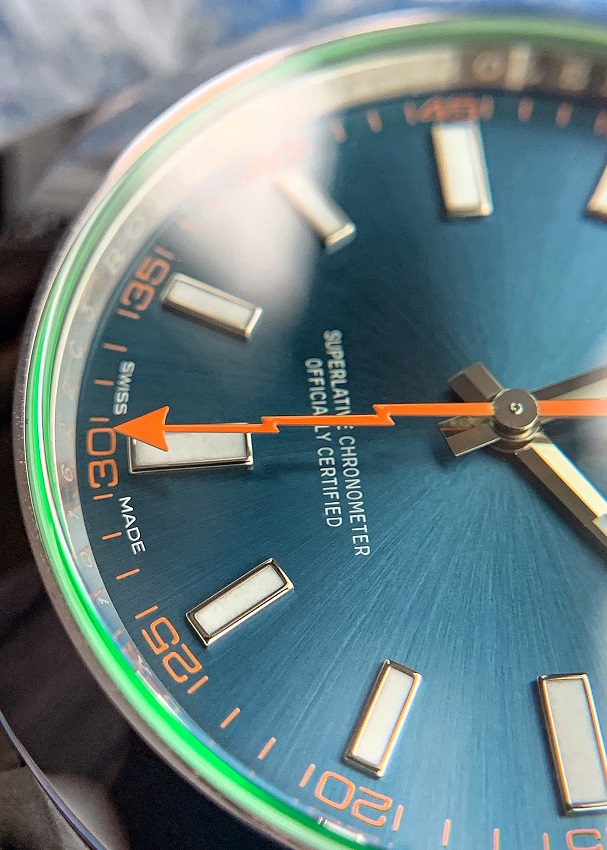
It is important to remember here that the wristwatch, during and following around the 1940s, was an incredibly important tool. Whilst today we are afforded the luxuries of technology in just about every aspect of our lives, during these decades it simply wasn’t the case. When pilots wore a wristwatch, it was a critical tool. When divers wore a watch, it was a critical tool upon which their lives depended. Tool watches, whatever their environment, need to be able to operate reliably to ensure they offer value to the wearer – including scientists.
Following the Second World War, a group of European scientists banded together with an idea to create a scientific lab dedicated to nuclear physics, and in 1949 the first discussions started. In 1951, the European Council for Nuclear Research, or in French, the Conseil Européen pour la Recherche Nucléaire, better known today as CERN, was born. Before long, scientists encountered one of the greatest enemies of wristwatches – exposure to magnetism.
For these scientists, whilst their wristwatch was perhaps not a tool which could mean life or death in the same way as it could for a diver, accurate timekeeping is nonetheless hugely important. What they found was that an electromagnetic field in the ambient environment of between 50 and 100 Gauss in strength (about the same as being close to a fridge magnet) would disrupt the operation of the watch, and they were essentially left with two options: 1) wear a watch and risk a high likelihood of it malfunctioning; or 2) simply not to wear one at all.
Rather conveniently, with CERN being based in Geneva, there was a raft of watchmaking expertise on hand… Enter Rolex.
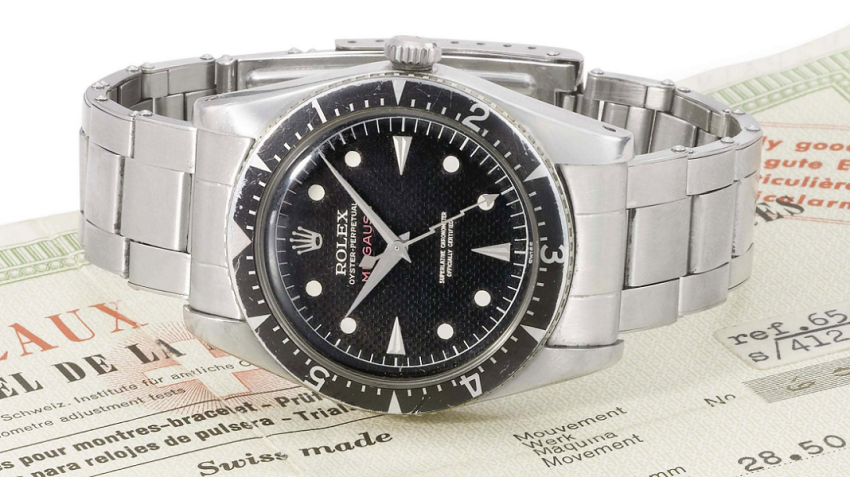
Rolex Milgauss reference 6541, photo - Christies.com
By 1956, they were ready to introduce the first Rolex Milgauss with references 6541 and 6543 – watches tested by the scientists at CERN and found to be capable of withstanding up to 1000 Gauss. Of course, having been tested by the scientists at CERN, it soon became a watch popular amongst the scientific community, capable of operating in the harsh electromagnetic environments in laboratories around the world.
As you might have already guessed, the name ‘Milgauss’ is derived from combining the measurement of magnetic field strength (Gauss) with the French word for thousand (mille).
Rolex achieved this resistance to magnetic fields through introducing a soft iron case around the movement which essentially acted as a Faraday shield, protecting the movement inside from both the electromagnetic fields in the environment and thus any subsequent disruption to its operation.
Given its rather niche origins, the Milgauss itself is a collection which doesn’t necessarily have the rich history and plethora of references we find with the Submariner, or Cosmograph Daytona for example.
(For more on these, check out books like The Book of Rolex, Vintage Rolex: The Largest Collection in the World, or Rolex Story – affiliate links).
After all, the world of lab coats and laboratories doesn’t conjure up the glitz and glam of international travel, motorsport and exploring the underwater world. The main prominent reference was the 1019, which was available in black or white dial, and whilst the orange lightning bolt seconds hand was an early feature, it did not stand the test of time the point that it was on every Milgauss model, with it being later swapped out for a more conservative ‘normal’ seconds hand. Ultimately, the 1019 was discontinued in 1988, and the Milgauss was no longer active in the Rolex catalogue.
It wasn’t until after a 19-year hiatus that the Milgauss returned in 2007 to mark its 50th anniversary, with Rolex announcing a new reference 116400 available in three models – a white dial, black dial, and a special black dial “Glace Verte” anniversary model with a green sapphire crystal.
Today, the Milgauss remains available in the Rolex catalogue in both a green and black dial, with both featuring this distinctive green sapphire crystal (as well as the orange lightning bolt seconds hand), and this green sapphire crystal is what I want to have a look at in a little more detail.
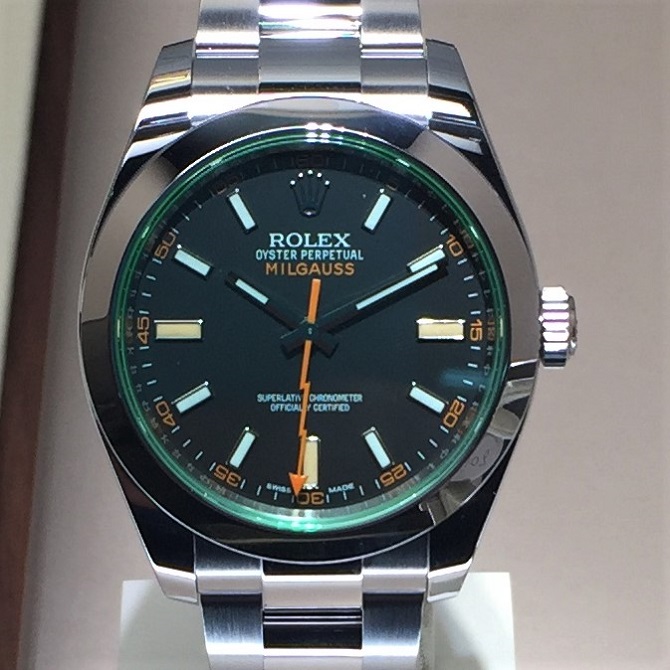
Rolex Milgauss 116400GV-0001

Rolex Milgauss 116400GV-0002
Rolex Milgauss and its Green Sapphire Crystal
As I mentioned earlier, the green sapphire crystal found on the Milgauss is not found anywhere else, on any other Rolex or indeed any other watch, making it very much a unique feature, and in my opinion worth a closer look.
Firstly, what does it do? Well, nothing really beyond aesthetics – and I think it looks awesome.
It is important to note that the green is not an applied colouring, or coating of any sort – the sapphire crystal itself is green, and this means that it is both scratchproof (the only material harder than sapphire crystal is diamond), and that it will never fade or discolour. The tint of the sapphire crystal is then accentuated at the bevelled edge of the crystal, and the green appears almost luminous to look at.
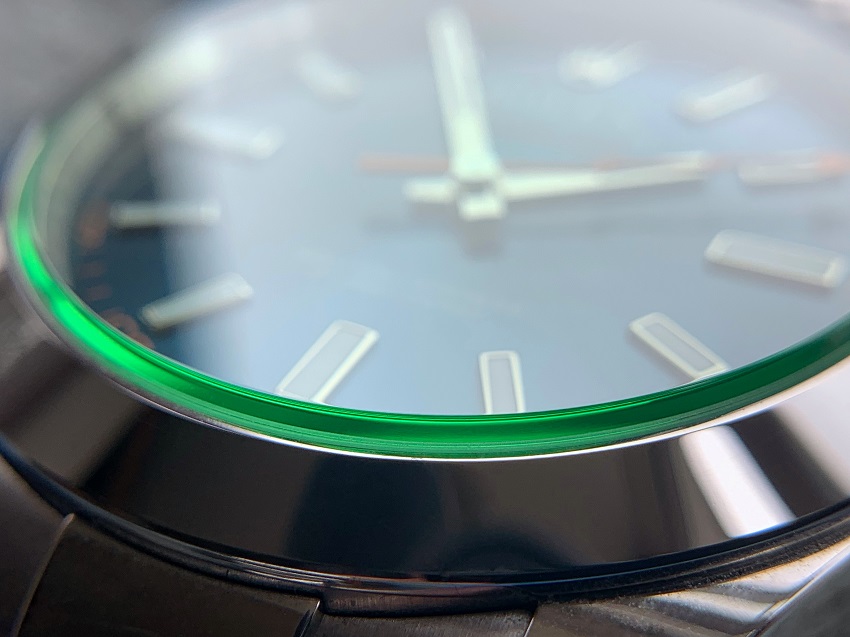
Green sapphire crystal on a Rolex Milgauss
Rolex says that the Milgauss green sapphire crystal took many years to develop ahead of the 2007 anniversary Milgauss launch, and of course the process itself that was developed is a closely guarded secret.
What we do know, however, is that the green sapphire crystal is synthetic and is grown, and there are well-known processes by which this is achieved.
Melt growth – this entails bringing an Aluminium Oxide compound to its melting temperature of 2040°C in a crucible (a bowl or pot capable of withstanding immense heat). A sapphire crystal is then formed by extracting some of the melted compound in what looks like a teardrop or boule shape, or gradually cooling it.
An alternative melt process is the Czochralski process, which uses radio waves to melt the compound. Once melted, a rod with a ‘seed’ crystal is dipped into the melted compound and slowly pulled out, which creates a rod of sapphire crystal. This process can create about 4 inches of sapphire crystal in an hour.
Solution growth – this entails using other substances to grow the crystal below its melting point, where a ‘seed’ crystal is again used with sapphire crystal growing around it.
The general consensus seems to be that Rolex are believed to use a hydrothermal method for growing their sapphire, which subjects the compound to intense heat and pressure in order to grow the crystal, similarly to how the sapphire crystal would be formed naturally.
I can well imagine this is not going to come cheap and is far from a simple process!
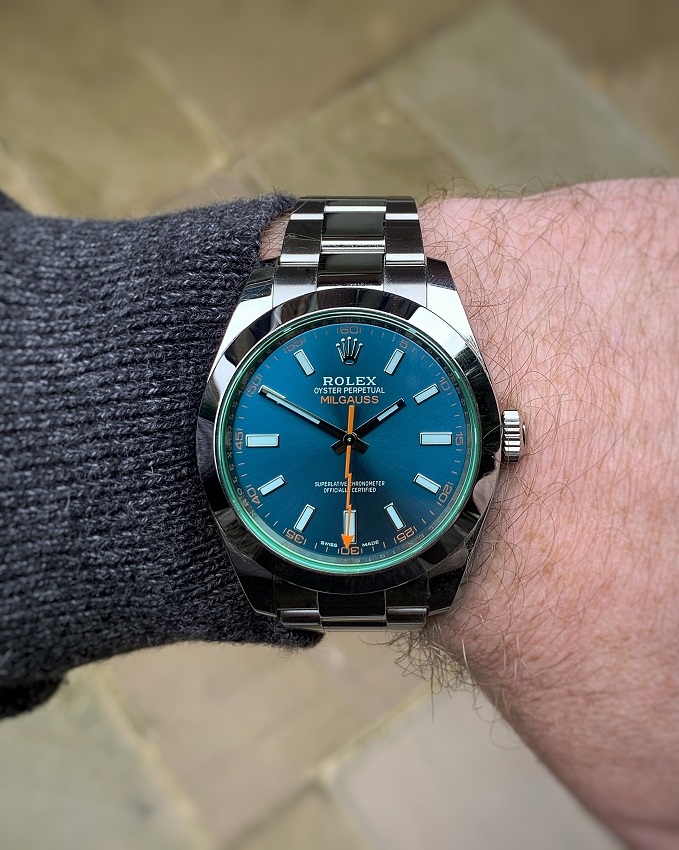
So, what makes the sapphire crystal green?
To achieve a green colour in synthetic sapphire, Copper is added to the Aluminium Oxide compound when the crystal is grown. The finer intricacy comes in balancing the volumes of chemicals to ensure that the green tint is as desired. Rolex say that the green sapphire crystal takes several weeks to grow, so it is easy to see just how painstaking the research and development into creating it must have been.
Rumour also has it that, contrary to the conventional approach of cutting the sapphire crystal perpendicularly through the boule or cylinder (similarly to how you might slice a cucumber), Rolex are rumoured to cut their crystal diagonally, which improves the strength and clarity of the crystal but also hugely increases the amount of waste.

In fact, one of my favourite facts about the Milgauss green sapphire crystal is testament to the incredible complexity that goes into producing it. After having ploughed unimaginable amounts of money into the research and development to create it, Rolex openly state that they didn’t take the time to patent their secret process, on the basis that it is so difficult to that they don’t anticipate that anybody would even try it! Quite a gutsy stance to take, but if anyone can carry it off, it’s Rolex.
In Summary
I think there’s an element of poetic justice that this green sapphire crystal is exclusive to the Rolex Milgauss; I like that something so simple on the surface which is born of such a complicated scientific process belongs on the watch which finds its DNA firmly rooted within the scientific community.
Whilst the Milgauss might not be the star of the Rolex show, or offer hundreds of references across a storied history, it is nonetheless a significant milestone in the history of watchmaking, given it was the first watch to really make strides against one of the antitheses of watchmaking in electromagnetic fields.
I am glad that it made a return to the Rolex catalogue after its time away, as I think it offers something different to the other professional watches, and the orange lightning bolt seconds hand combined with the green sapphire crystal serve to add a pop of colour to the watches and add a playful element to the watches. The green tint is something that is quite easy to both dismiss the complexity of and gloss over given it is purely visual, however I hope that from reading this you will take away a greater appreciation for what has gone into creating it, and enjoy it that little bit more.
If you have any questions, or want to share your thoughts, please get in touch via our Contact page, or via our Instagram.
You might also be interested in:
- Spotlight: Dive Watches
- Watch Accuracy Standards
- Watch Finishing Techniques
- Watch Stationery and Gift Ideas
- Watch Books, Watch Boxes and more at the Watch Affinity Shop on Amazon (commissions earned)
As an Amazon Associate, I earn from qualifying purchases – thank you for your support

